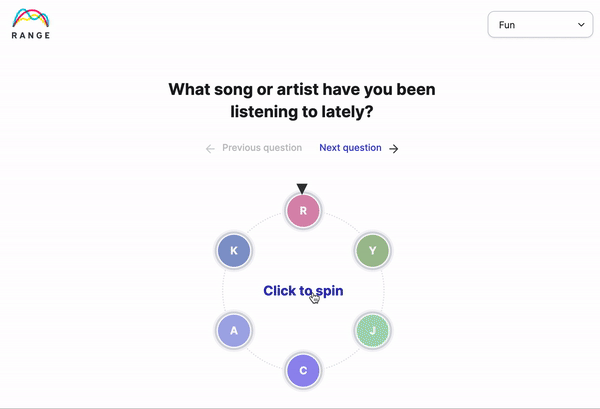Do you use the words goal and objective as interchangeable phrases when you talk with your team members or outline your professional goals and plans?
Goals and objectives are often confused with each other, as they both describe desired outcomes and results that you or your company want to achieve.
What sets goals and objectives apart?
Goals and objectives can be differentiated by 4 things:
- The timeframe
- The level of concreteness
- The way you measure them
- The effect they have on your organization
While the terms are often used interchangeably, they have major differences and significant implications for your company.
It's critical that each person on your team is on the same page when it comes to this terminology.
In this post, we’re going to describe the difference between goals and objectives and provide clear examples to help you overcome vagueness in your company communication.

No sign-up required
Try our (free) icebreaker spinner
Take a spin! Start your next meeting with one of these icebreaker questions. It works the same way in Range.
What are goals?
What are goals? Goals determine the broad, long-term outcomes you want to achieve. They give you the overarching direction for your business plan and define where you want to be in the future.
You might use goals in your yearly and quarterly company strategy, in your positioning, mission statement, company culture guide, financial projections, and other crucial business documents and initiatives.
The right goal will align with your company vision, purpose, and long-term aspirations.
A goal establishes a desired outcome. An individual company goal is a broad statement; it is large in size and intangible. That’s why it’s hard to measure.
As a team or organization, your goals could be to:
- Increase international customer base
- Foster a more inclusive company culture
- Improve cross-team communication
- Build trust between cross-functional departments
While these are worthy goals, they don't include a specific action or timeframe that guides you through each step to reach your destination.
What defines an “inclusive company culture?” What are the particular tasks you need to complete? How would you know you've reached the goal?
A goal describes where your company wants to be in the future, but unlike objectives, it doesn't detail how you get there.
What are objectives?
What are objectives?
Objectives are the specific actions and measurable steps your company must take to reach its goals.
They give you a clear understanding of the specific tasks or projects that need to be completed in order to get your organization closer to the target.
Usually thought of as OKRs, these have very specific action steps and metrics attached to them.
- 15% in new leads in this quarter compared to last
- 20% more revenue from a key partner this quarter
- Establish more than $500k in sales pipeline
- 7 new deals closed more than $75k this quarter
The difference between goals and objectives
Goals and objectives are different concepts, but they work in harmony to help you achieve the desired results and maximize your team’s productivity.
Creating a goal without a clear objective leads to a goal that never gets accomplished.
Goal definition:
The direction and overall destination of your company that helps you realize the company vision
Goal characteristics:
- General intent or direction
- Broad in scope
- Large in size
- The action is a general outcome
- Goals are not strictly measurable
- Long-term timeframe

To make goals actionable, they need to be broken down into objectives and KPIs (key performance indicators). Here is how you could break down an example goal into a measurable objective:
- Business goal: Increase international customer base
- Objective: Acquire 28% more customers from the UK, Australia, and Germany in the next three months
- Outbound sales team objective: Reach out to 20 additional international prospects per week
- Product department team objective: Translate the onboarding flow and reduce the time for onboarding from 12 days to five days for all international customers in the next three months
- Marketing department team objective: Reduce cost-per-click from $2.50 to $0.50 for international digital ad campaigns and increase the reach from 100 to 500 people per week
Objective definition:
The exact actions and steps your company must take to reach its goals
Objective has the word “object” in it. Objects are concrete.
Because of this, objectives can be scoped with timeframes, budgets, and tangible results. A lot of organizations use the S.M.A.R.T. criteria and goal setting method to define and measure objectives.
Objective characteristics:
- Specific and precise
- Narrow in scope
- Small chunks that make up the outcome of the goal
- The actions are specific and measurable
- The metrics are simple, straightforward, and tangible
- The timeframe is medium or short-term
S.M.A.R.T. is an acronym for:
- Specific — Objectives have a high level of concreteness with real metrics and deadlines that need to be tracked. For example, “Generate 50 leads from the UK before 30 Oct” is more specific than “increase the international customer base.”
- Measurable — Make sure that you can track the success of your objective. What’s the key performance indicator (KPI) that you’re going to track? (Don't forget to identify the person responsible for tracking each objective.)
- Attainable — An objective is challenging but possible. “Helping 10 million international businesses be more productive” is admirable but not very actionable if you have 100 customers. Don't try to conquer the world overnight.
- Relevant — Is the objective related to your long-term goal, and does it align with your company vision?
- Time-bound — Your objective needs to have a concrete deadline (target date). “Someday” is not a day of the week.
Leadership tip: Align objectives with business goals
As a leader, be sure your team's day-to-day tasks and projects align with the broader needs of the business.
As Chris Bee, CTO at Lessen, shared in our Lead Time Chat on the behaviors of effective engineering leaders, "There's a tendency sometimes for shiny object syndrome as people start to get into leadership roles." He noted that it's important for folks to keep in mind "where the business is headed and the goals that we're trying to reach."
Connect your goals and objectives with Range
Connecting goals and objectives in practice can be a challenge, especially for distributed teams, but tools like Range can help.
With Range, teams can bridge the gap between goals and daily work by setting goals and objectives aligned to broader business goals and linking those objectives to specific projects and tasks.

- Set a goal for metrics, objectives, and KPIs
- With hashtags, see all artifacts, updates, and day-to-day progress in one place
- Share goal updates with leaders via Slack or email
- Integrate with tools like Slack, Asana, Trello, GitHub and more
- Easily track goals and objectives across all your work streams








